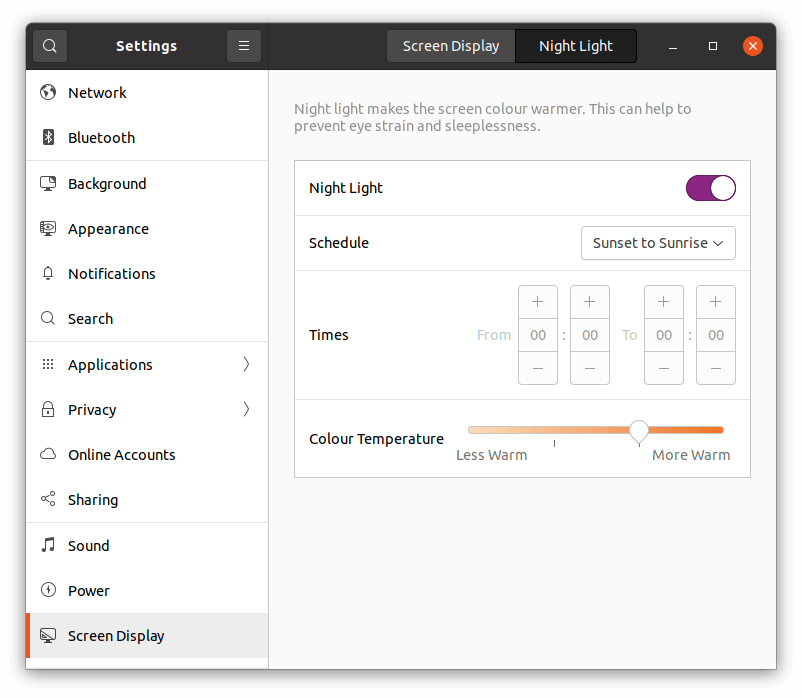Last Updated on May 22, 2022
8. Enable Night Light
Many people who regularly use computers suffer from eye strain and fatigue. Looking at a monitor for a long time can strain your eyes or can make any other problems you are having with your eyes seem more apparent. There is also research to show that late-night exposure to bright lights can affect sleep quality. This can be mitigated by reducing blue-light exposure.
Ubuntu already comes with a tool to reduce the amount of blue-light exposure. You only need to activate the feature.
Open Settings from the Dash. Select Screen Display, and then select the Night Light tab.
In the image below, you can see there’s a slider to enable Night Light.

We have chosen the Sunset to Sunrise schedule, but we can also define a specific time to start and stop the night light. We can also configure the colour temperature.
If you need more functionality, check out Eye Care: Best Free Linux Software to Look after your Eyes for our recommendations.
Summary
There’s lots of things some users might want to do after a fresh installation of Ubuntu. It’s impossible to cover them all in a single article. But we’ve covered the fundamentals.
We don’t recommend manually configuring a firewall. iptables is the built in firewall for Ubuntu Desktop. But the default desktop installation has no ports open and no servers running. ufw is software for managing the firewall. It’s also pre-installed but configured to do nothing. For most home Ubuntu users there’s no need to configure either iptables or ufw.
There’s tons of replacements for the software already pre-installed with Ubuntu. For example, many users prefer using Google Chrome rather than Firefox as their web browser even though Chrome is proprietary software. But things like that are largely personal decisions.
Nevertheless, newcomers can easily be bamboozled by the sheer number of open source software available. To help new users, we have assessed many thousands of open source programs from an independent and unbiased view and selected our favorites.
The next part in this series will exmaine the Ubuntu desktop.
Pages in this article:
Page 1 – Initial Update
Page 2 – Install Drivers
Page 3 – Enable Backups
Page 4 – Video/Audio Codecs and TrueType Fonts
Page 5 – GNOME Tweaks
Page 6 – GNOME Extensions
Page 7 – Install BleachBit
Page 8 – Night Light and Summary
All articles in this series:

Why only cover Ubuntu?
From independent surveys Ubuntu is the most popular Linux distro. Ignore the charts you see on some web sites that often have fairly obscure distros top. Their fanboys just vote them up using bots, partly because they are very passionate about them.
Interestingly, Linus Torvalds (the creator of the Linux kernel) has never even tried Ubuntu.
What about the command line? Newcomers shouldn’t only use GUIs in my opinion.
How about what to do when app doesnt have a package?
How about as a Linux user you whine, cry and criticize ever tutorial and article ever printed? It really gets old. I use Linux, I use Ubuntu, I use other OS’s. I appreciate people with the skill and knowledge to write tutorials and articles that can help others. No article can cover ‘everything Linux”. Thank you Steve.
We welcome suggestions what information you think is helpful for newcomers to Linux. When you’ve been using Linux for as long as we have, it’s easy to overlook things which would help beginners.
We will be covering the command-line in a later part of this series. But there’s a few important areas we need to cover first.